The Kaiser's men’s medals
Article about: The Kaiser's men’s medals (and Homelands) Some time ago acquiring this postcard for my collection. It’s a small piece of art on paper that someone used on April 21, 1916 It’s an incred
-
02-25-2024, 04:25 PM
#181
-
02-25-2024, 04:28 PM
#182
-
02-25-2024, 04:34 PM
#183

Santi, now everyone knows why you have been knighted with the "purple" moniker  . I feel like I owe you residuals for reading this fascinating history for free. Keep up the excellent work. This along with your fascinating "vacation" history tours are marvelous
. I feel like I owe you residuals for reading this fascinating history for free. Keep up the excellent work. This along with your fascinating "vacation" history tours are marvelous
-
02-25-2024, 04:55 PM
#184

Thanks Al (and rest of friends) for your kind words. It's fantastic that we all enjoy these things. I can only tell you that I have material for a few hundred more posts.
Regards
Santi
-
02-28-2024, 03:59 PM
#185

SAXONY ALTENBURG
Sachsen Altenburg was one of the three Ernestine Duchies (Sachsen Coburg-Gotha, Sachsen Altenburg and Sachsen Meiningen) located in the present-day Land of Thuringia and which, together with the Grand Duchy of Sachsen Weimar-Eisenach and the Principalities of Schwarzburg and Reuss, formed a set of micro-states, known as the Thuringian States.
Thus, Sachsen Altenburg was a German Duchy (Herzogtum Sachsen Altenburg) located in central Germany
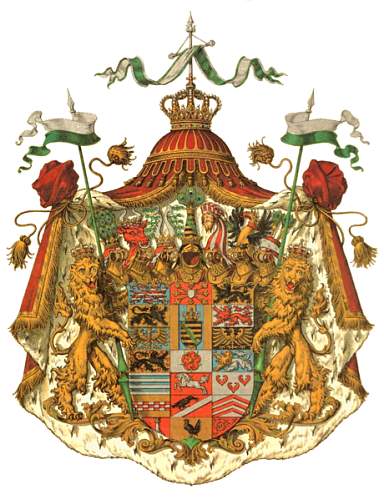
Herzogtum Sachsen-Altenburg
Its population of 216,000 inhabitants extended over a discontinuous territory of 1,323 km2 (divided into three larger portions and an exclave). Its capital was Altenburg, which currently has a population of 33,000.
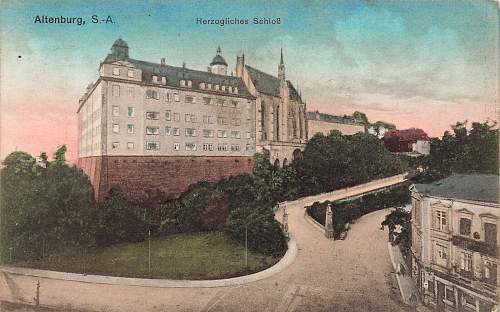
Altenburg
Its form of government was that of a constitutional monarchy. The executive power is held by the Duke. During World War I the Duke was Ernest II (7 February 1908 – 14 November 1918). He abdicated with the German Revolution of 1919.
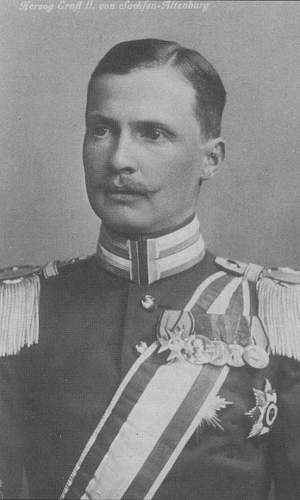
Ernst II Herzog von Sachsen-Altenburg
After the defeat of 1918 and the Revolution of 1919, the Duchy was abolished, and Altenburg became part of the Free State of Thuringia (1 May 1920) during the period of the Weimar Republic. After the Second World War, the territory of Thuringia remained in the Soviet occupation zone and in 1947, when the GDR was formed, it became the Land of Thuringia. After reunification in 1990, Thuringia is one of the sixteen German federal states, with Erfurt as its capital.
To determine what this state contributed to the Empire, we must know
ITS POLITICAL WEIGHT.
The German imperial parliament was structured in the Constitution of 1871, in the form of a bicameral system, composed of the Reichstag of 397 deputies, divided among the states of the Empire in proportion to their population; and the Bundesrat, with 61 territorial representatives
Sachsen Altenburg contributed 1 deputy to the Reichstag and 1 territorial representative to the Bundesrat.
ITS MILITARY CONTRIBUTION.
At the beginning of World War I, the Imperial German Army, which was structured on the basis of a regimental unit based on territory, consisted of 218 infantry, 110 cavalry, 101 field artillery and 25 heavy artillery regiments.
The four Saxon duchies, Anhalt and the three Hanseatic cities, each contributed an infantry regiment to the Kaiserliches Heer.
-
02-28-2024, 04:02 PM
#186

DECORATION.
The Tapferkeitsmedaille 1916-1918.
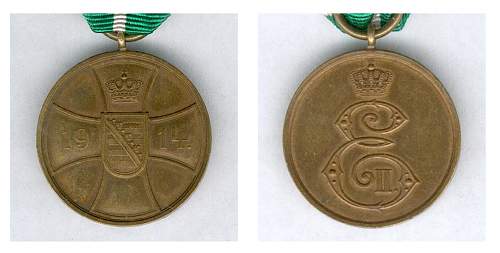
The Medal of Valor (Tapferkeitsmedaille 1916–1918) was an award instituted by Duke Ernst II in February 1915 for officers and non-commissioned officers belonging to the 8th Thuringian Infantry Regiment No. 153 as well as citizens of the Duchy in other units.
The medal was awarded for acts of special valor in the face of the enemy. Its recipient had to be in possession of the Iron Cross 2nd Class, in order to receive it. Four variants of material are known. Bright bronze, bronzed zinc alloy, copper-coated zinc alloy and buntmetall. It is a circular bronze medal with a flange, with a welded ring for the suspension of the ribbon; on its obverse, a cross pattée with the coat of arms of Saxony. On the upper vertical arm, a crown; the left arm - 19 -; in law - 14 -. On its reverse, the monogram of Duke Ernest II (an "E" with the Roman numeral two), surmounted by the ducal crown. The ribbon has green and white stripes. From 1916 to 1919, a total of 11,900 medals were minted in all the alloys noted.
In bronze, about 520 were awarded.
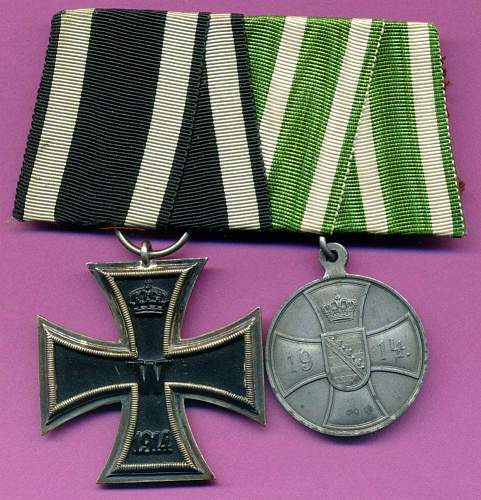
EK2 1914 - Tapferkeitsmedaille
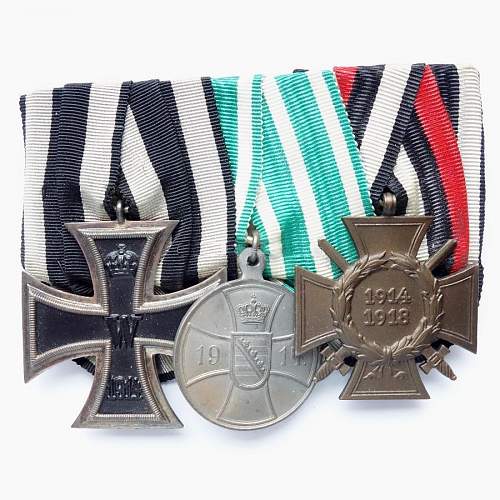
EK2 1914 - Tapferkeitsmedaille - Ehrenkreuz für Frontkämpfer 1914-1918
-
03-02-2024, 11:58 AM
#187

In case anyone had doubts about it, throughout this thread we will also talk about these three imperial decorations.
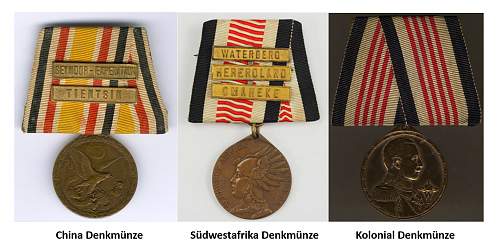
From the point of view of military collecting, for me they are three true wonders. But from a historical point of view we will discover a lot of stories within the History of the Second German Reich itself.
For each one of them, I will talk about the medal itself and later about the campaign or campaigns for which they were awarded: their battles, their protagonists, their anecdotes...
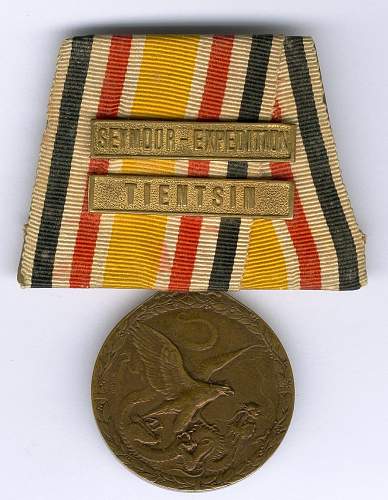
China Denkmünze
The Commemorative Medal of the Chinese Campaign will reveal to us the stories of a most idealized and heroic adventure in our popular culture.
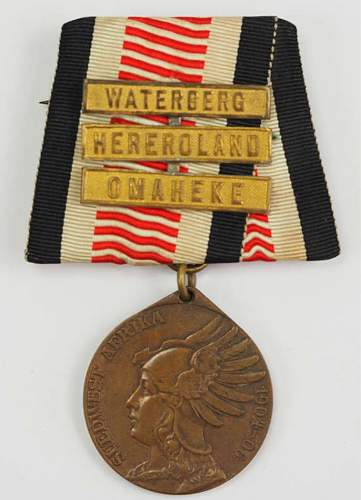
Südwestafrika Denkmünze
When we talk about the Commemorative Medal of the German South West Africa Campaign, we will find very curious things, but also a dark stain on the history of Imperial Germany.
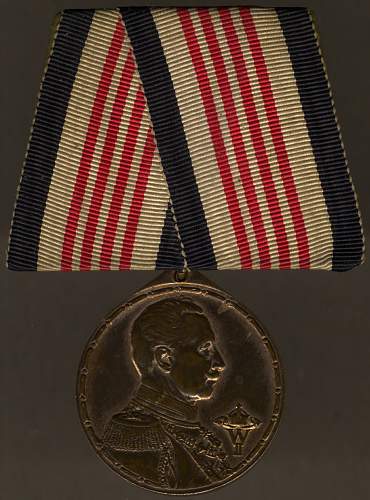
Kolonial Denkmünze
Finally, for the Colonial Commemorative Medal (as we will see in a few weeks) I have chosen a truly curious adventure, both because of the surprising place where it occurred, and because of its reasons and consequences.
Last edited by TabsTabs1964; 03-02-2024 at 06:03 PM.
-
03-02-2024, 12:10 PM
#188

The Eagle against the Dragoon
German Empire, China commemorative medal, awarded in 1901.
The China commemorative medal was donated by Kaiser Wilhelm II on May 10, 1901, in bronze for all participants in the military events in East Asia, namely the fight against the Boxer Rebellion between 30th May 1900 and 29th June 1901, as well as for those who were involved in caring for the sick and wounded in the war zones People of both genders. The steel commemorative medal was given to all people who were involved in the preparations for the formation and deployment of the German armed forces, as well as the crews of the German shipping companies' transport ships of troops and war supplies to and from East Asia.
The design comes from Kaiser Wilhelm II himself, but the medal was executed by Professor Walter Schott, Berlin. The medals were minted at Mayer & Wilhelm, Stuttgart.
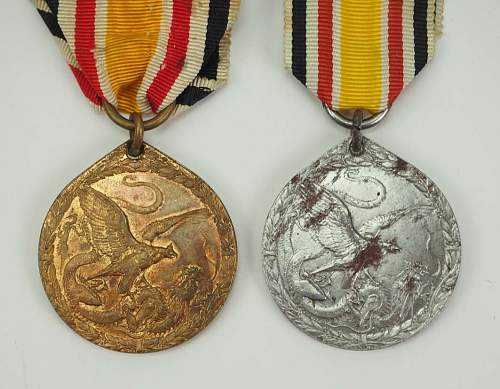
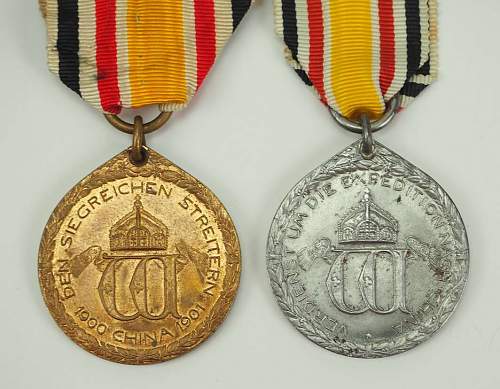
Obverse: An eagle holding a dragon in its claws.
Reverse: The imperial initial, above the imperial crown.
Bronze commemorative coin, the inscription “The victorious warriors 1900 China 1901”
Steel commemorative coin, the inscription: “Service for shipment to China”
The medal could also be awarded with the following clasps if the recipient participated in the corresponding skirmish or battle:
Taku
Seymour-Expedition
Tientsin
Peking
Peitang-Forts
Liang-Hsiang-Shien
Kaumi
Tsekingwan
Kalgan
Huolu
Kitchou
Hophu
Fouphing
Nang-Hung-Men
Kuang-Tschang
Tongku
Chou-Cho-Nang
Nan-Kuan-To
Nankuanto
Tschang-Tschöngling
Lang-Fang
Peitzang
Below, two examples of clasps on the medal ribbon
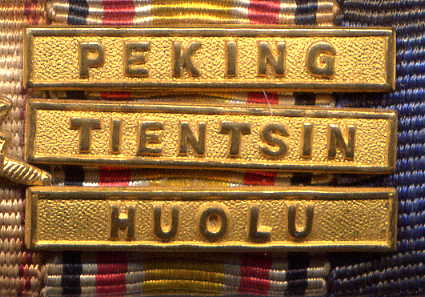
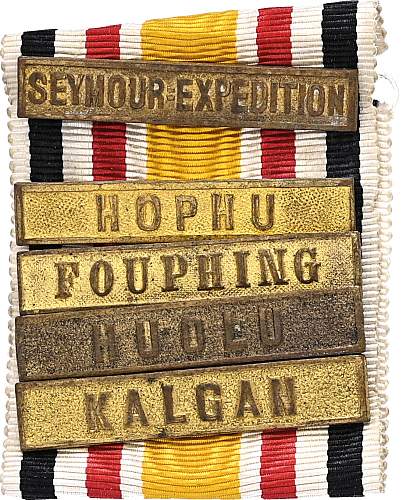
Below are two examples of the medal award document
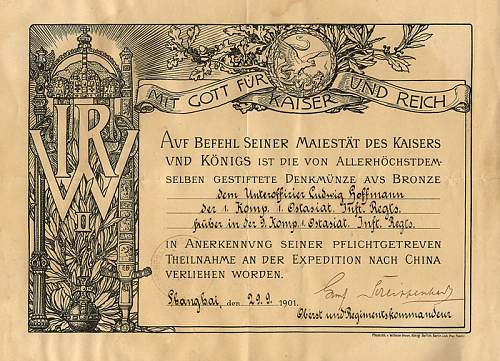
Urkunde (certificate) of Unteroffizier Ludwig Hoffmann
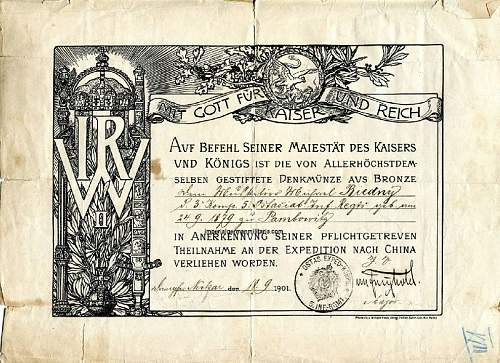
Other Urkunde (certificate)
-
03-02-2024, 12:14 PM
#189
-
03-02-2024, 12:22 PM
#190
Similar Threads
-
In New users approval forum
-
In Medals, Orders & Decorations
-
In Field equipment, kit and other
 Posting Permissions
Posting Permissions
- You may not post new threads
- You may not post replies
- You may not post attachments
- You may not edit your posts
-
Forum Rules



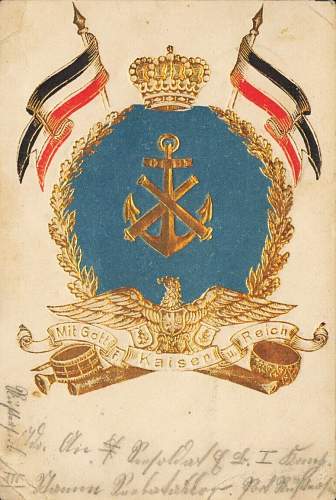
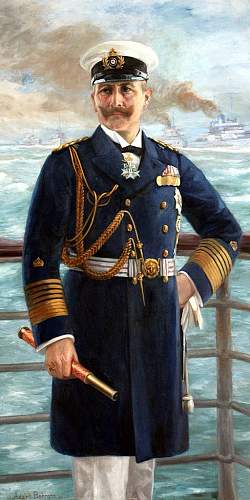
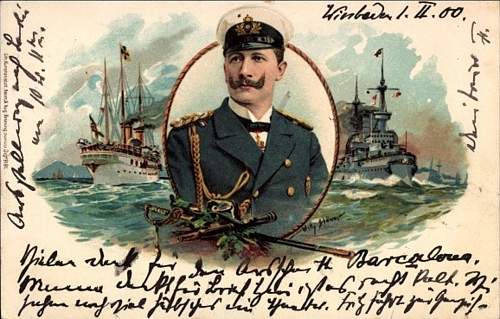
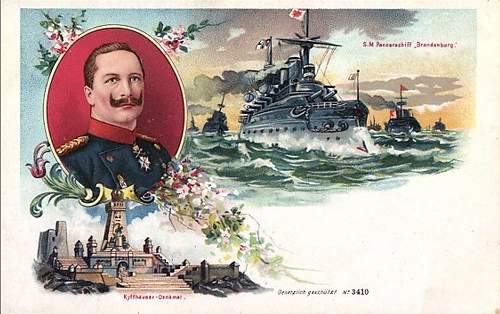

 .
.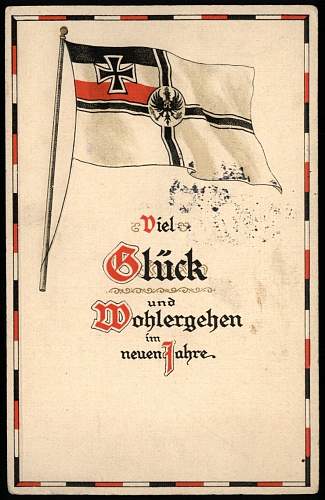
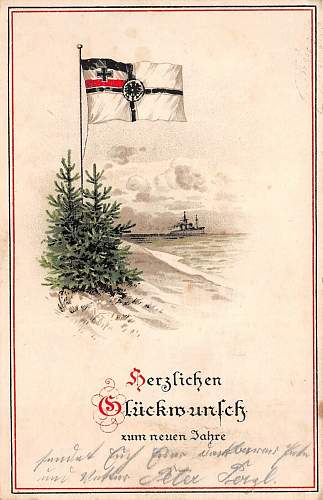
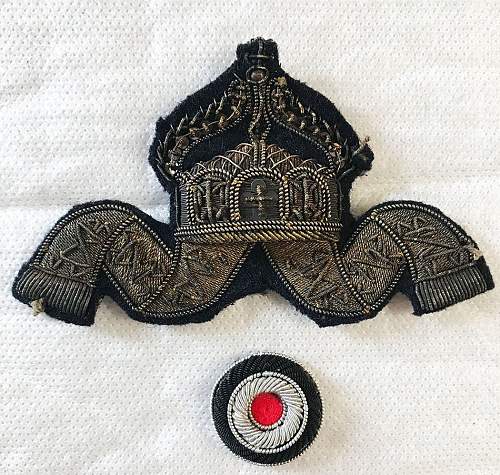
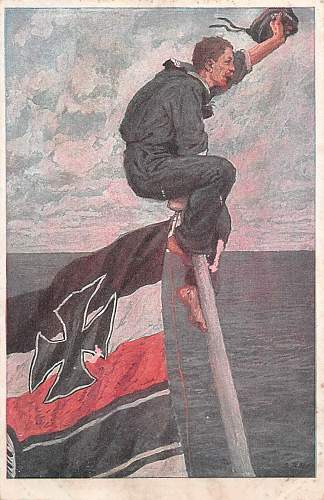
 . I feel like I owe you residuals for reading this fascinating history for free. Keep up the excellent work. This along with your fascinating "vacation" history tours are marvelous
. I feel like I owe you residuals for reading this fascinating history for free. Keep up the excellent work. This along with your fascinating "vacation" history tours are marvelous
















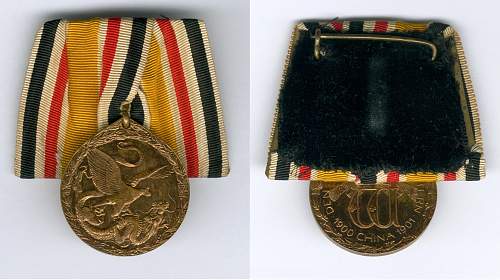
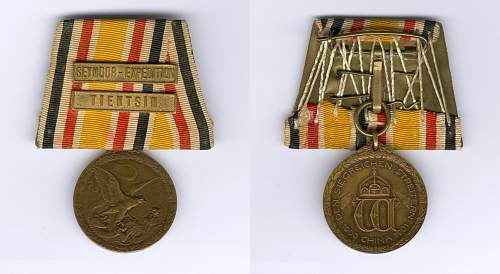
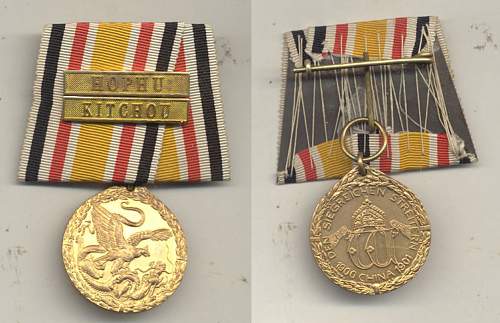
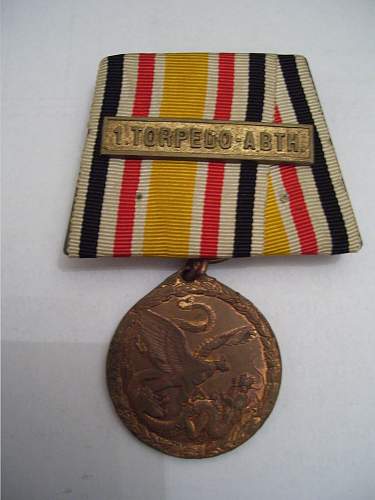
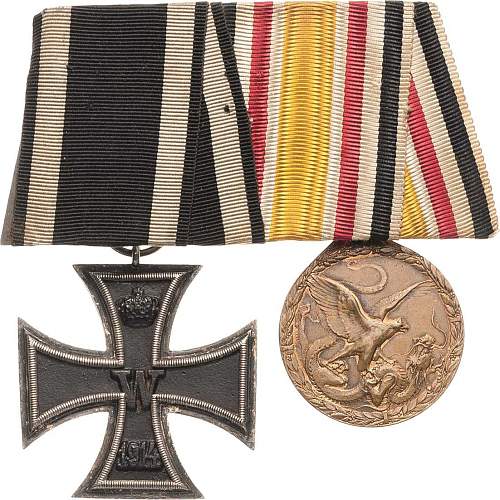
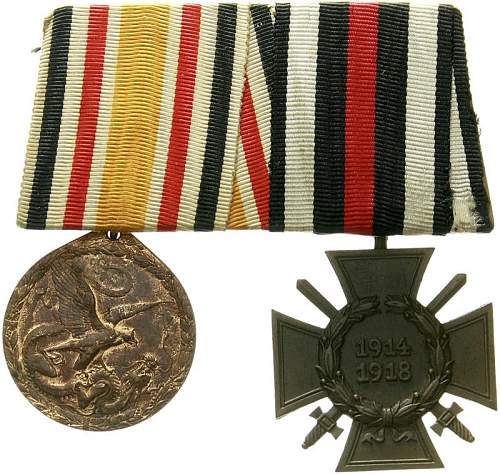
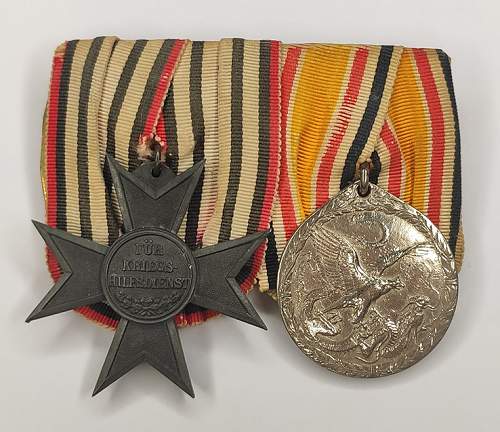
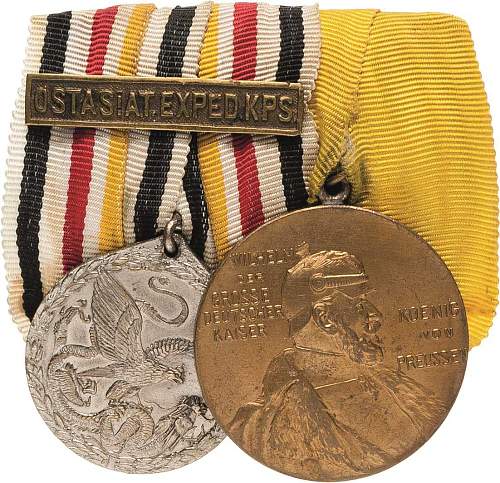
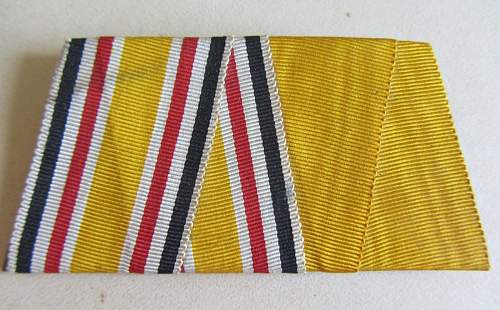
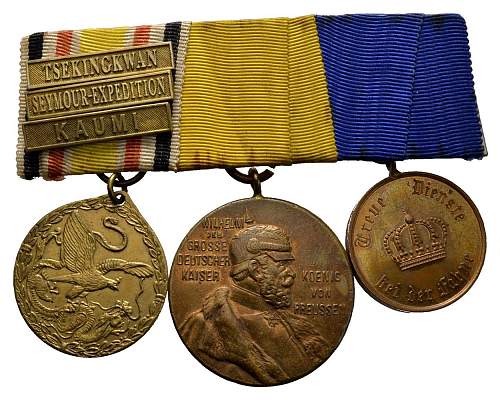
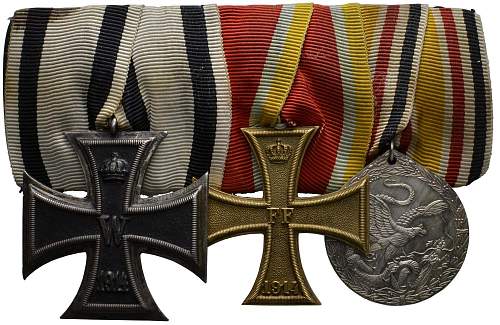


Bookmarks